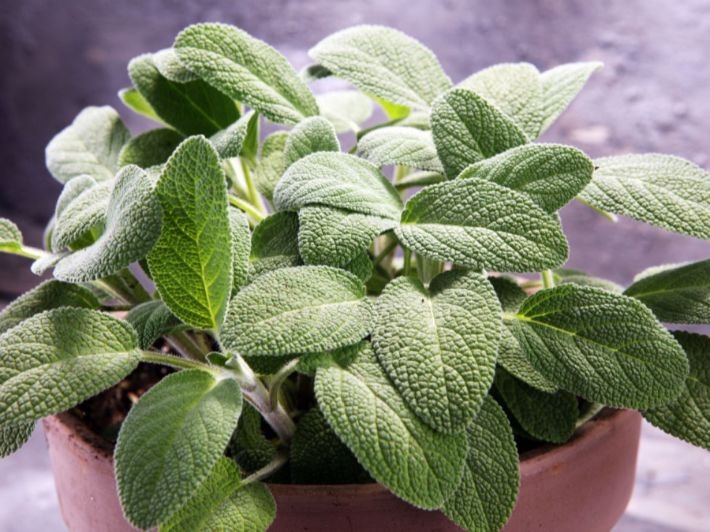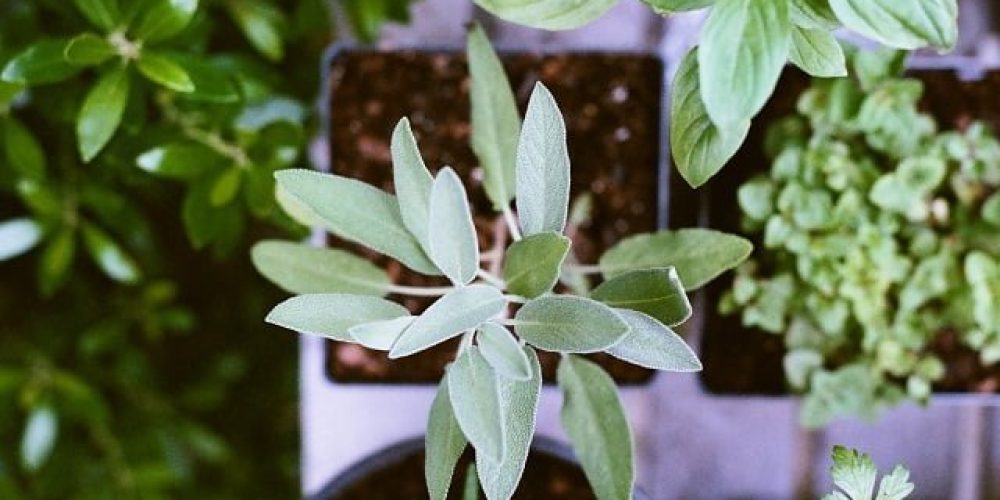Table of contents of the article
ToggleSage is an aromatic herb that is very popular thanks to its health benefits and multiple uses in cooking and therapy. And in this article on your site botanist WORLD of PLANTS, we will dwell on the properties and uses of sage and how to grow and care for it.
What is sage
Sage is one of the herbs that are used in food flavoring and has many medicinal uses and is green and gray in color and is included in many medical prescriptions and is involved in the manufacture of some cosmetics and aromatherapy , as well as has a great ability to attract bees .
Properties and uses of sage
Sage has a soothing properties and an antibiotic that works to give the body the ability to fight infections, help expel gases and reduce sweating, and sage contains in its components a number of volatile oils, including thujone, cineole, enalol, borneol, camphor, pinene, flavonoids and resin
Sage is usually used in the treatment of infections of the mouth, throat and tonsils, which helps to calm the mucous membranes, where it is used as an infusion in hot water, and drinking sage helps reduce milk in the breast, calms stress and headaches, and also helps improve gums and improve the smell of mouth when rubbing teeth, helps To accelerate the treatment and healing of wounds. It also helps in tightening and stimulating the muscles of the uterus, so you should avoid taking it during pregnancy, it helps to relieve flashes during menstruation .

Cultivation of sage
Suitable soil for sage
Sage can be grown in any type of soil that is well-drained and ventilated, and in general, yellow soil is considered the best soil in which to plant .
Reproduction
- A. The cultivation of sage can be carried out by seeds, which are planted in February until seedlings are formed .
- P. It can be planted by cuttings, but here cuttings should be treated with a rooting hormone and planting begins at the end of summer and use prepared cuttings from March .
- C. One acre of sage needs from 6000 to 7500 seedlings, but if the cultivation is to be carried out in a reserve, the acre needs about 7500 seedlings .
Preparing the soil for planting sage
- A. Add municipal fertilizer to the soil at a rate of 12 to 15 cups per acre .
- P. Stir or plow the soil well for aeration and mix the fertilizer with the soil .
- C. Leveling the soil .
- Dr. Add superphosphate fertilizer at the rate of 150 kg per acre .
- E. The layout of the soil should be the distance between the line and next to it from 70 to 90 cm .
- And. Seedlings are planted so that the distance between the seedling and its neighbor is from 20 to 30 cm .
Watering sage
Sage is one of the plants that tolerate extreme thirst for long periods, as this plant does not lose water quickly because its surface is covered with hairs and fluff, so the plant is watered at intervals of up to three weeks between watering and the next in winter, but in summer, watering is done every two weeks and does not need abundant watering, excess irrigation It affects the amount of volatile oils with a shortage, here it must be taken into account that the number of watering times should not be less than 6 irrigations, provided that watering stops at least a week before harvest .
Fertilizing sage
Sage needs to be fertilized with fertilizers at the following rates :
- Superphosphate at a rate of 150 kg per acre .
- 37.5 kilograms per acre of potassium sulfate .
- Ammonia Sulfate at the rate of 150 kilograms per acre .
Half of these quantities are added about three weeks after planting , the other half is added two weeks after the addition of the first half , after picking, it is preferable to give doses of ammonia .
Pests and diseases that affect sage
Viral diseases – - yellowing of leaves, viral leaf spotting and to combat these diseases, you must follow a long-term agricultural cycle, work on uprooting infected plants from the roots and burn them .
B-fungal diseases: - fungal leaf spot , powdery mildew, stem rot, root rot and control is carried out by avoiding excessive watering , planting in suitable soil, disinfecting the soil, soaking the seeds in water with a temperature between 40 and 50 degrees Celsius for 20 to 30 minutes, seed treatment or cuttings With fungal antiseptics, use the appropriate fungicide .
C-nematodes: - they are combated by uprooting infected plants from the roots, burning them, working to sterilize the soil and treating it with a suitable pesticide for nematodes before planting .
Harvesting sage
The flowering of the plant begins in late March and lasts until May, and the flowering increases with the passage of years and the harvest is done by cutting the plant and two cuttings are taken in the first year, or in the following years two cuttings are taken, provided that mowing or mowing is done in the daytime and the plant is cut so that about 15 cm of the plant is left above Soil until the plant resumes its growth and cultivation lasts about four years, then the planting is transferred to a new spot .
The most important guidelines for growing sage at home
Sage is an aromatic herbaceous plant, its leaves are velvety, characterized by its strong taste and unique aromatic aroma, and Sage is characterized by its ease of cultivation, as it does not need much care and care, the following are some things to follow when growing sage:
First: - choosing the right location for planting sage
The main key to the success of growing Sage is to expose it to the sun on a daily basis and at least 6 to 8 hours a day; so the first thing to consider when choosing the right location for planting Sage is to ensure that sunlight reaches the plant for at least 6 hours as a minimum.
Second: - preparation of suitable soil for planting sage
The most important thing to consider when choosing the type of agricultural soil for Sage is good drainage of water, as excess moisture may lead to stimulation of fungal growth, which in turn will lead to root rot and plant death; therefore, it is recommended to plant Sage in sandy soil, and in the absence of sandy soil, it can be planted in clay soil mixed with organic matter.
Third: - choosing the most suitable time for planting sage
It is advisable to start planting sage during the spring; as this is the most suitable time for planting sage, specifically when the soil temperature reaches (18 Celsius).
Fourth: - watering and caring for sage
As for watering Sage, Sage is a plant that does not like excess moisture, because excess moisture only brings harm, so it is not recommended to water sage unless the soil is completely dry. As for taking care of the sage, as we said earlier, the sage plant does not need much care.
How to grow sage
Sage can be grown by following one of the following methods:
First: - planting sage with seeds
One of the disadvantages of this method is that it takes patience, because sage seeds need at least 6 weeks to start germinating, but in general it's easy and simple, all you have to do
Second: - scattering sage seeds over the soil
Cover the sage seeds afterwards with a light layer of Earth, and all that needs to be done later is just to keep the soil moist.
Third: - planting sage with branches
What distinguishes this method from other methods is that the sage grown in this way grows faster than those grown in other ways, and the secret of the success of this method lies in the fact that the sprig is taken from a mature Sage Plant, strong and completely free of diseases, and the sprig is green and tender, because the Woody branches cannot form buds As for how to plant sage with branches, the following should be followed to plant it:
- Cut the branch to be planted approximately 10 cm long.
- Place the twig in a glass of water or in a rooting hormone until the roots grow.
- Plant the rooted twig in the pot, after making sure that the roots have grown.
How to care for a sage plant at home
Below we list the highlights that relate to the care of this herb:
- Keep the plant in a warm place within a temperature of 21 degrees Celsius.
- Provide the necessary moisture to the plant, taking care to water it in the right amount, and make sure that the soil is dry before the next watering operations.
- Use the mature and fresh leaves of the plant at least 3 times a week instead of using them dried, as this stimulates the growth process.

In conclusion, we would like to note that we, at the world of plants website, offer you all the necessary services in the world of plants, we provide all farmers and those interested in plants with three main services::-
- Artificial intelligence consulting service to help you identify diseases that affect plants and how to deal with them.
- Blog about plants, plant diseases and care of various crops ... You are currently browsing one of her articles right now.
- An application that provides agricultural consultations to clients, as well as a service for imaging diseases and knowing their treatment for free – Click to download the Android version from Google Play Store، Click to download the IOS version from the Apple App Store.
References




